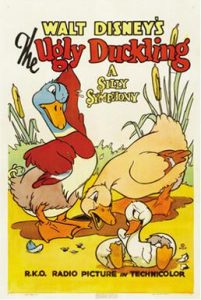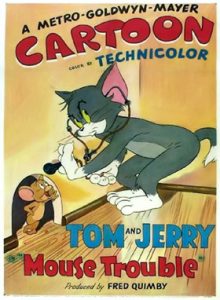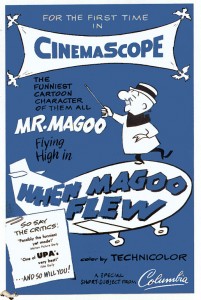


 When Johnny Carson hosted the Academy Awards, he once called it: “Two hours of sparkling entertainment spread out over a four-hour show.”
When Johnny Carson hosted the Academy Awards, he once called it: “Two hours of sparkling entertainment spread out over a four-hour show.”
Yes, the show can go on a bit long. Still, thankfully for animation fans, one of the awards sandwiched there, in the midst of the opening monologue and the Best Song musical numbers, is the Academy Award for Best Animated Short Film.
Through the years, a number of now classic animated shorts from the golden age of cartoons have taken home the gold in this category. To commemorate this year’s Oscars airing this coming Sunday on ABC, here is a look back at just four of these classic animated shorts, each an Oscar winner for Best Animated Short Film that year and each one also celebrating an anniversary this year.
The Ugly Duckling (1939) – Disney – 85th Anniversary
This Disney Silly Symphony is a heartfelt and heartbreaking little film that, like the best of the studio’s short films, packs tremendous emotion into its brief run time.
 Directed by Jack Cutting and Clyde Geronimi, it tells the Hans Christian Andersen Tale (which Disney had adapted once before in 1931). The Ugly Duckling opens with a mother and father duck eagerly awaiting their eggs to hatch.
Directed by Jack Cutting and Clyde Geronimi, it tells the Hans Christian Andersen Tale (which Disney had adapted once before in 1931). The Ugly Duckling opens with a mother and father duck eagerly awaiting their eggs to hatch.
When one does, out pops a cute, little white ducking who looks different than their siblings (they even make a “honk” sound, while the others quack), and is ultimately shunned by the family and sets off on their own.
Trying desperately to find another family, the dejected Ugly Duckling is alone, until a mother swan and her cygnets embrace and adopt them, as the Ugly Duckling was indeed a beautiful swan.
As the short ends, the little swan sees the former duck family but sticks their nose in the air and swims off.
Except for “honks and quacks,” The Ugly Duckling is told without the benefits of dialogue and with some wonderful character animation eliciting great personality that connects with the audience (among the many talents who worked on the film were legends such as Milt Kahl and Eric Larson).
From their humorous first appearance on screen, where they appear wearing half an eggshell, to a sequence where they desperately try to befriend a decoy duck, it’s easy to feel for the brokenhearted Ugly Duckling.
The short is also filled with beautiful sequences (the backgrounds are credited to Samuel Armstrong and Phil Dike), including an evocative one where the dejected Duckling walks through the woods as shafts of light shine through the trees.
It’s no wonder that The Ugly Duckling took home that year’s Oscar and became considered a classic Disney short subject. Like the title character discovering they’re a swan, these are fitting victories for The Ugly Duckling.
Mouse Trouble (1944) – MGM – 80th Anniversary
This outing deserved its Oscar as it was the epitome of a Tom and Jerry cartoon and crafted with sharp humor.
 Tom eagerly awaits a book in the mail, “How to Catch a Mouse” (“A Random Mouse Book”). As Tom reads each chapter throughout the cartoon, we get vignettes as he tries out the book’s advice to capture Jerry.
Tom eagerly awaits a book in the mail, “How to Catch a Mouse” (“A Random Mouse Book”). As Tom reads each chapter throughout the cartoon, we get vignettes as he tries out the book’s advice to capture Jerry.
Tom attempts a mouse trap, but it is his finger that gets caught in it; he attempts to trap Jerry with a snare, but Jerry replaces the cheese with a dish of milk, and Tom gets caught; he chases Jerry into a corner when the book assures him that a cornered mouse never fights, after which Jerry pummels him (followed by Tom, breaking the fourth wall, looking at the camera and declaring “Don’t you believe it!” the catchphrase of a popular radio program at the time, of the same name).
In another mishap, Tom also loses his hair and hysterically wears an orange toupee for the remainder of the film while trying to trap Jerry with a wind-up female mouse that continually repeats the famous Mae West line, “Come up and see me sometime.” Tom inadvertently swallows the wind-up toy and repeats the Mae West line every time he hiccups.
Finally fed up with all his efforts, Tom acquires explosives (A LOT) and places them around Jerry’s mouse hole. When the explosion happens, however, it’s Tom who takes the brunt of it, turning into an angel floating into the clouds, constantly hiccupping, “Come up and see me sometime.”
With the legendary William Hanna and Joseph Barbera directing and fellow legends such as Kenneth Muse and Irv Spence animating, Mouse Trouble is solid gold Tom and Jerry, so it’s no surprise it brought home the gold on Oscar night.
 When Magoo Flew (1954) – UPA – 70th Anniversary
When Magoo Flew (1954) – UPA – 70th Anniversary
Just as Mouse Trouble was a quintessential Tom & Jerry cartoon, When Magoo Flew is a quintessential Mr. Magoo outing.
As the cartoon opens, Mr. Magoo (voiced by Jim Backus) is leaving his house to go to the movie theater. In a bit of a self-deprecating jab, the theater that Magoo passes plays “The Tattle Tale Heart “(just one year after UPA released an animated adaptation of Edgar Allen Poe’s The Tell-Tale Heart).
Magoo’s nearsightedness has him thinking that the airport across the street is the theater, and he boards an airplane, thinking it’s a movie theater. He even believes that the film’s name is “Fasten Seat Belts,” and the film’s 3-D is shockingly realistic.
Magoo watches an interaction between the stewardess and a police officer who is looking for a man with a briefcase who is wanted (and happens to be seated next to Magoo). Magoo, of course, thinks that this is the film.
He winds up opening the door and wandering out on the wing when he gets hold of the briefcase. He wants to return it to lost and found. He then winds up inadvertently turning it in to the police officer and solving the case.
Directed by Pete Burness and written by Barbara Avedon and Tedd Pierce, When Magoo Flew is a marvel of non-stop nearsightedness gags, coupled with well-executed animated choreography. As Magoo sits in the plane, thinking he’s at the movies, he marvels at the effects, exclaiming, “You can feel the plane moving!” Later, while walking precariously on the wing, he looks out at the sky and says, “Oh, that widescreen!”
As Magoo disembarks the plane, thinking he is leaving the movie theater, he thanks the stewardess, saying that he enjoyed the movie, but notes that he wishes there had been a cartoon and asks if they ever show many starring that near-sighted man.
Yes, those Mr. Magoo shorts were always welcomed by audiences, and this one most definitely deserved a welcome from Oscar.
The Pink Phink (1964) – UA – 60th Anniversary
“Remember me? First, I was a movie title…now I’m a movie star!!!”
This is what the poster for The Pink Phink declared, as it was the first cartoon short to star the Pink Panther since he starred in the animated opening credits of the live-action movie of the same name.
 Phink is an apt title for this debut short, as that is precisely what the Pink Panther is, spending the entire short torturing a painter who is trying desperately to paint a house blue. At the same time, the Panther follows along, painting it pink.
Phink is an apt title for this debut short, as that is precisely what the Pink Panther is, spending the entire short torturing a painter who is trying desperately to paint a house blue. At the same time, the Panther follows along, painting it pink.
The Pink Panther does everything to the put-upon painter, from painting pink stripes to putting pink paint in a sprinkler and turning it on to spray an entire room. When the painter grabs a shotgun, the Pink Panther fills it with pink paint, and when it’s fired, it turns a blue house pink, one shot at a time.
As it is the character’s style, there’s no dialogue in the short, just Henry Mancini’s iconic Pink Panther theme from beginning to end, like wonderful, musical wall-to-wall carpeting.
The Pink Phink was directed by Friz Freleng, with co-director Hawley Pratt, two legends from Warner Bros., who most definitely knew how to stage perfectly timed sight gags. Here, it’s coupled with a sparse stylized look (at times, it’s just the characters against a white background) that uses color and design brilliantly. Even the painter (known in the Pink Panther cartoons as “the Little Man”) is a simple, egg-like shape with arms, legs, eyes, nose, and mustache.
The character of the Pink Panther would evolve through the years, but it’s interesting to look back on his first appearance, where he excels at troublemaking. The filmmakers creatively generated genuine laughs, which rightfully caught the attention of the Academy, bringing Oscar gold to The Pink Phink
These are just four of the many Oscar-winning animated short subjects through the years since the award was first presented in 1932. Each was celebrated by the Academy, is celebrating an anniversary this year and set a gold standard.